Today Garmin announced a new accessory alongside the Forerunner 935, the Running Dynamics Pod. This tiny pod, about the size of a piece of small candy, essentially provides the existing Running Dynamics data (i.e. Vertical Oscillation/Ground Contact Time) that normally comes from the HRM-TRI/HRM-RUN units. All while doing so in something not much bigger than a peanut.
I’ve been using one for about a month, so plenty of time to sort through the ins and outs of it. This post covers everything you’d possibly want to know about it, and then a lot more you didn’t want to know about it. By the same token, it doesn’t have a ton of functions, so I’m going to attempt to keep things as brief as you might expect around here. So only about 30-40 pages or so.
Oh, and like usual, I’ll send back the little yellow loaner RD Pod to Garmin once done with it for this post. Just the way I roll. Haven’t quite decided the most economical way to mail it back. Perhaps I’ll just put it inside a the Peanut M&M’s bag and stick some stamps on it. That should work, right?
Size Matters:
Most importantly, before tech, let’s talk size. If for no other reason than I have a bag of candy. I mean, bags of candy, sitting around.
The RD pod is small. Smaller than a Garmin footpod for example. In fact, it’s so small that it doesn’t take a CR2032 coin cell battery like almost every other ANT+ device on this planet. Instead, it takes a CR1632 coin cell battery.
But how big is the unit? Well, I set out to the grocery store to find something to compare it to. A pile of candy bags later, I figured I had some valid comparison options that folks can find the world around.
You can see here that it’s clearly bigger than a Peanut M&M, as well as bigger than a Maltesers. Further, it’s bigger than a mini Kinder Easter egg candy.
However, it’s actually almost identical to that of the Werther’s Original candy, once you remove the wrapper.
In fact, it’s so identical that you can swap the pod inside the little pod holder for a piece of candy. They both fit perfectly.
As for the weight? It comes in at a mere 12g:
As you probably ascertained from the earlier photo of the candy inside the pod clip, the pod does fit inside a small rubber clip. Thus how it attaches to your person. Assuming you’re the person.
How it works:
So the purpose of the pod is to replace the data given by your HRM-TRI or HRM-RUN straps. Or rather more specifically, the Running Dynamics data from those devices. The idea behind it is with the rise of optical HR sensors, it seemed silly to keep requiring people to buy HR straps – creating duplication. Yet, that was the case for anyone that wanted the additional data. That data can’t be obtained from the wrist because it depends on having a more balanced center-point. Or at least something that’s not swinging around in the wind as you wave at that hot guy or gal across the street.
So the pod clips to the back of your running shorts, in many ways like the initial prototype Stryd Running Power Meter did, or, how the Lumo pod does. It does NOT clip to your running shoes. It is NOT a footpod. Nor, is it a candy to eat (a mistake I almost made a moment ago while eating some of those Maltesers in a small pile next to my laptop).
The device has an accelerometer inside, just like the HRM-TRI/HRM-RUN straps did. With that accelerometer it’s able to measure the following metrics:
– Running Cadence
– Vertical Oscillation
– Vertical Ratio
– Ground Contact Time
– Ground Contact Time Balance
Like the HRM-TRI/HRM-RUN, it does *not* measure pace. Unlike those straps though, it doesn’t measure your heart rate (seems obvious, but I figured I’d mention it). Note that your Garmin wearable already measures cadence via the wrist, so this is doubling down on that. It provides what is generally considered higher fidelity cadence data (like a footpod would), since it’s not prone to errors based on wrist movement (i.e. holding a water bottle or a camera).
While the RD pod was announced today in conjunction with the FR935, it’s actually compatible with a few units. At this time these are as follows:
– Forerunner 735XT
– Forerunner 935
– Fenix 5, 5S, 5X
The most obvious missing watch from the above would be the Fenix 3/3HR series. Personally, I think that’s a pretty big omission. And even more, I think Garmin is just leaving free money on the table there. People that would have bought a Fenix 3/3HR in the last year aren’t likely to buy a new watch. But they are likely to splurge on a $69 pod like this.
I can certainly see the logic in skipping something like the FR630 – since that hasn’t had updates in a while, but the others seem odd omissions. Hopefully, they’ll change their mind.
Note that it’s definitely not going to be compatible with watches that never did Running Dynamics data to begin with (i.e. the FR230/235/Vivoactive HR/etc…). But, I think for relatively recent watches that already support Running Dynamics, it’d be a pretty easy addition for the company.
When it comes to using the pod, you’ll pair it in the sensors menu like any other sensors. In the case of the FR935 today, it shows ‘RD Pod’ as a sensor type. The Fenix 5 will shortly as well (next few days), as well the FR735XT.
However interestingly, with the FR735XT it’ll actually find the RD automatically if you go into the sensors menu. It’s just sneaky about it right now.
Once paired, the sensor doesn’t have any other options beyond showing up.
The watch will let you know it found the pod at the start of a session, just as it would any other sensor.
During the activity, you’ll get Running Dynamics data populated on the two Running Dynamics pages (or any custom pages you’ve created).
And afterwards you’ll get summary data including metrics like Ground Contact Time and Vertical Oscillation. However, my favorite part is actually the little message you’ll get after you’ve saved and closed out your run.
This handy little reminder keeps you from accidentally sending the pod through the washing machine. While I’m sure it’d have no issues there, it’s the dryer that tends to be more problematic (if using very high heat). The unit is waterproofed though, so it’s just a matter of whether or not the heat is too high to do damage.
A pro tip on the pod: When it gives you that message? Simply connect it to your shoe laces. That way next time you run and you see the ‘RD Pod Connected’ message, you know to reach down and stick it on your shoes. If you forget – don’t worry, the clasp is strong enough it won’t likely fall off.
The Data:
Ok, so you’ve gone out and done a run – what’s the data look like? In a nutshell, exactly like that of the Running Dynamics previously. If you crack open your activity on Garmin Connect, you can see how the data appears. Here’s a recent run of mine if you want to poke around (FR935 with RD Pod). Here’s what the full activity looks like first:
Ok, but the parts with the RD part are actually a bit more specific, they’re these sections here:
And again remember cadence does come from the RD pod, but it also comes from the wrist. In this case, the RD pod takes priority.
So you’ll see Vertical Oscillation above, but you can toggle that to Vertical Ratio (as seen below), and you can toggle Ground Contact Time (GCT) as seen above, to GCT Balance as seen below:
You can also zoom in on these stats if you’d like, such as the GCT balance stats. And within that you can add in overlays (other data fields). For example, below I added cadence and heart rate:
The above makes it super clear that as I increase intensity (which is pace in this case on a flat course), that it tweaks my running cadence (higher), and that in turn changes GCT. Note that I’m using HR in the chart above rather than pace, simply because the HR data looks prettier. Pace is technically the correct field to compare against.
Finally, at the bottom of the activity in the summary section you’ll get the averages. I’ve highlighted in yellow the specific fields that come from the RD pod (or the HRM-RUN/HRM-TRI).
Now, how does this compare against data from the HRM-TRI or HRM-RUN straps? Glad you asked, let’s move onto the next section.
Video Overview:
I went ahead and put together a full video showing from start to finish how the RD pod works, inclusive of about a 6-8 minute long analysis section doing side by side comparisons of data from the same run. One recorded with the RD pod, and one recorded using the HRM-RUN/HRM-TRI straps. It’s like the Running Dynamics Battle Royale!

Oh, and in case you want to play around with the data yourself – here’s the files from that run (use the download link on that page). Or you can play with them on Garmin Connect instead. FR935/RD pod here, Fenix5/HRM-RUN here. Do be careful on the Fenix5 one that you’re looking at the Garmin Running Dynamics metrics graphs, and not the Stryd running dynamics metrics graphs (they have a little ‘IQ’ next to them). Two different sensors!
Wrap-Up:
So – what do I think of the pod? It’s good. Not great, not bad, just good.
Meaning, it works perfectly fine and does 100% exactly what it set out to do. It also does so in a really tiny package that no longer requires you to wear a heart rate strap. For a bunch of people – they’ll be really happy about that. And the metrics largely seem to align between the existing straps and the new pod. Not precisely spot-on the same, but I suppose that’s somewhat to be expected since they are measuring in slightly different places. But they measure far closer than units I tested in the running efficiency post last month. So that’s good news.
So don’t take this the wrong way – if what you’re after is Running Dynamics data, then this absolutely delivers. It’s just for me, it’s not something I have a lot of clarity on what to do with. So, I generally don’t put a lot of emphasis on it. And as such, I have less excitement over. No different than someone giving me a piece of cardboard versus a cookie. I know which one I prefer. Oh, and Peanut M&M’s.
In any case – with that – thanks for reading!
Found This Post Useful? Support The Site!
Hopefully you found this review useful. At the end of the day, I’m an athlete just like you looking for the most detail possible on a new purchase – so my review is written from the standpoint of how I used the device. The reviews generally take a lot of hours to put together, so it’s a fair bit of work (and labor of love). As you probably noticed by looking below, I also take time to answer all the questions posted in the comments – and there’s quite a bit of detail in there as well.
If you're shopping for the Garmin RD Pod (Running Dynamics Pod) or any other accessory items, please consider using the affiliate links below! As an Amazon Associate I earn from qualifying purchases. It doesn’t cost you anything extra, but your purchases help support this website a lot. Even more, if you shop with TPC (The Pro's Closet), you'll save $40 on purchases over $200 with coupon code DCRAIN40! The Pro's Closet has been a long-time partner of the site here - including sponsoring videos like my cargo bike race, as well as just being an awesome Colorado-based company full of good humans. Check them out with the links below and the DCRAIN40 coupon!
And of course – you can always sign-up to be a DCR Supporter! That gets you an ad-free DCR, access to the DCR Quarantine Corner video series packed with behind the scenes tidbits...and it also makes you awesome. And being awesome is what it’s all about!
Thanks for reading! And as always, feel free to post comments or questions in the comments section below, I’ll be happy to try and answer them as quickly as possible. And lastly, if you felt this review was useful – I always appreciate feedback in the comments below. Thanks!


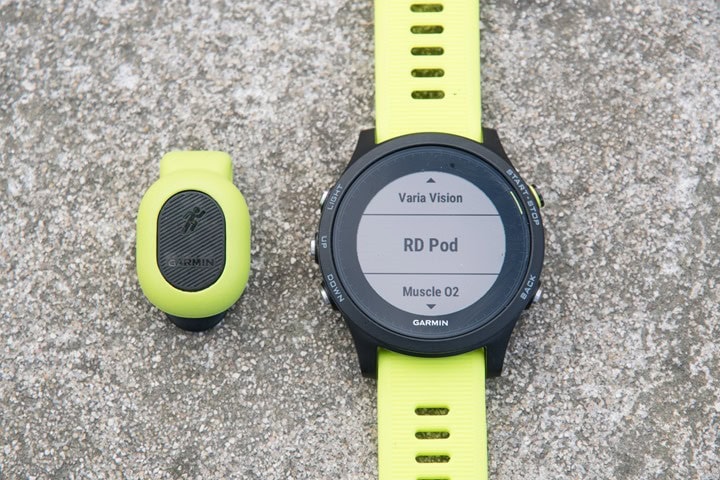
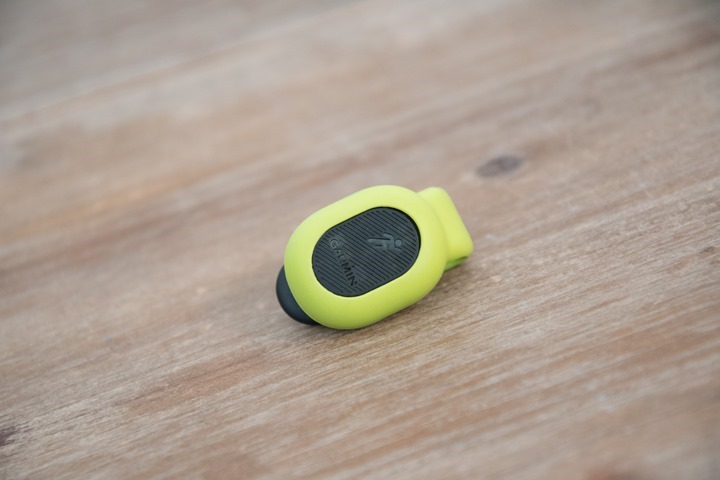
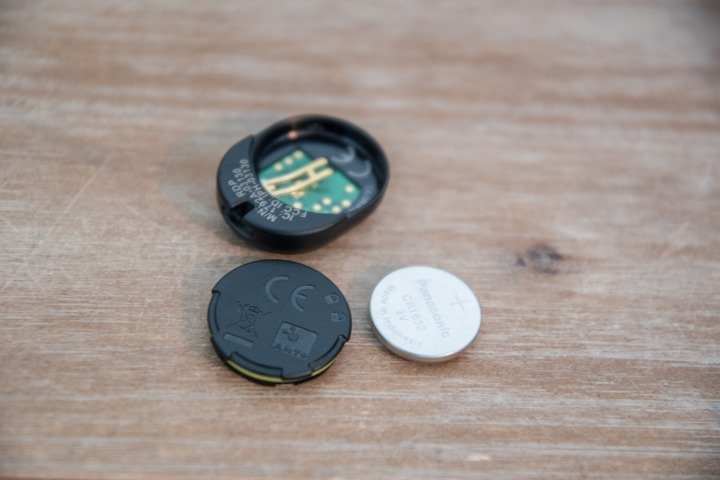
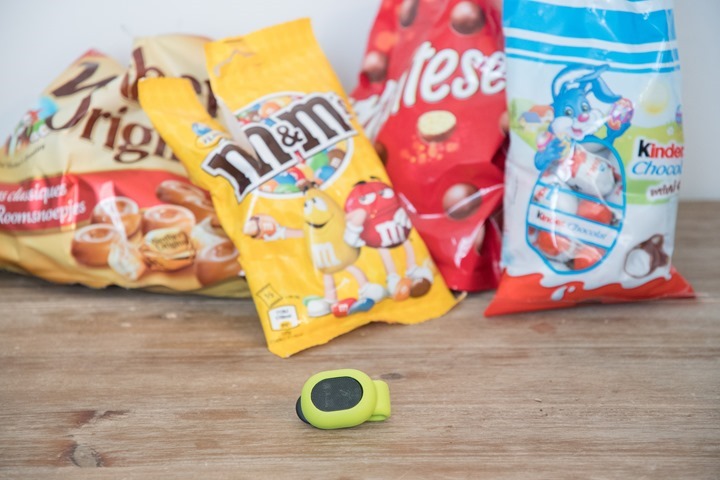
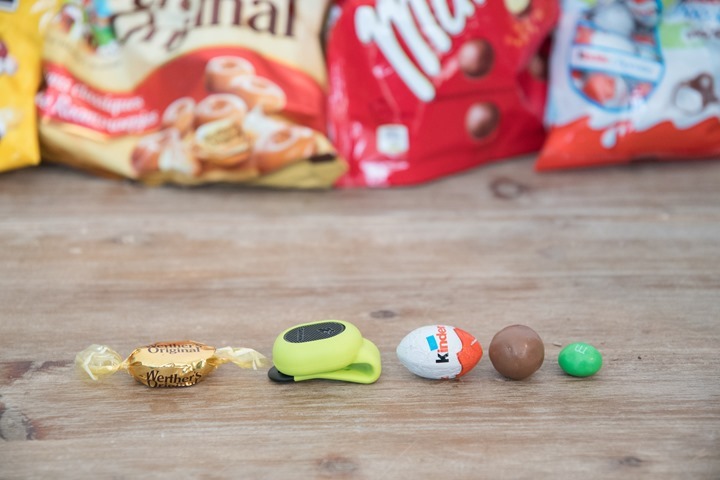
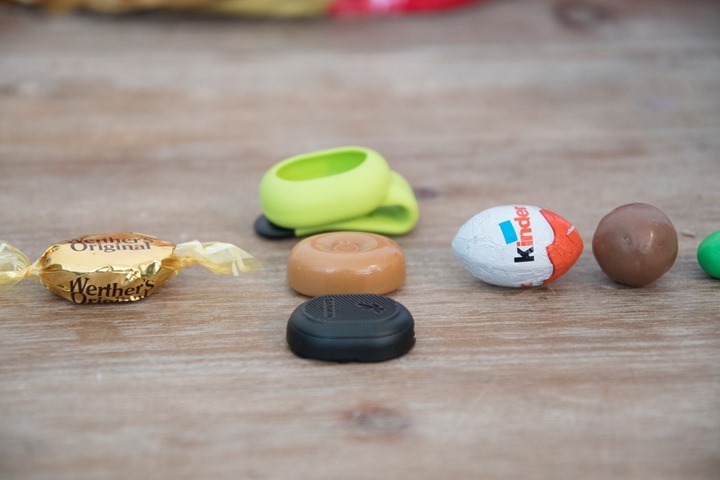
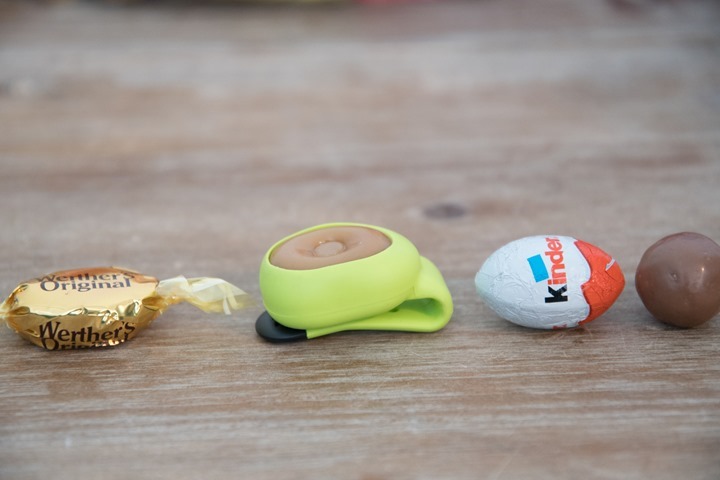
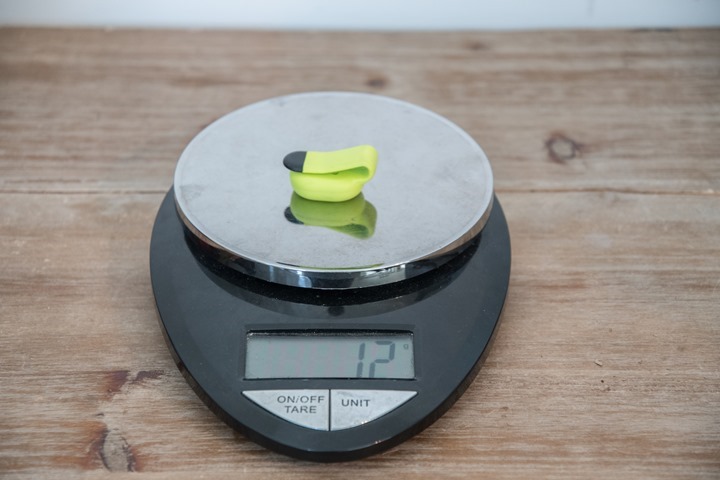
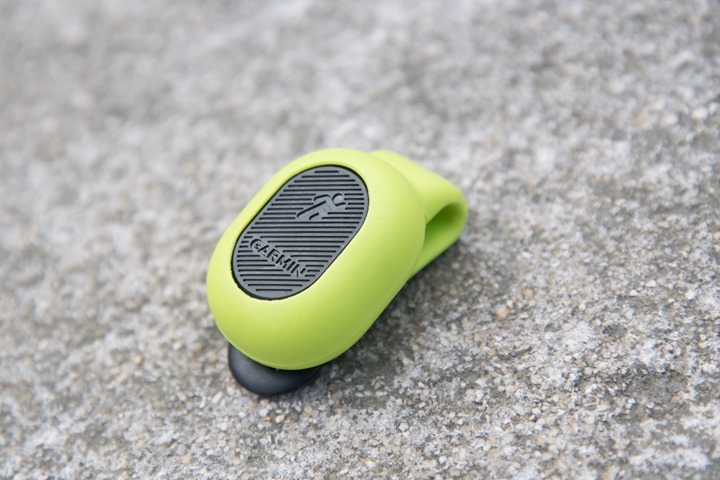
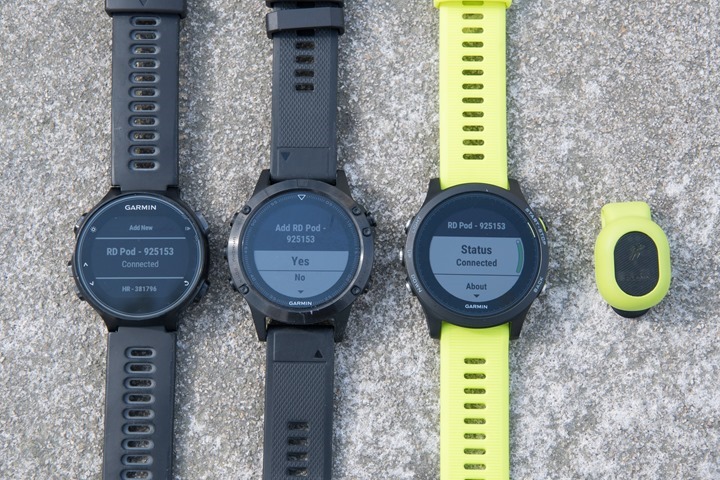
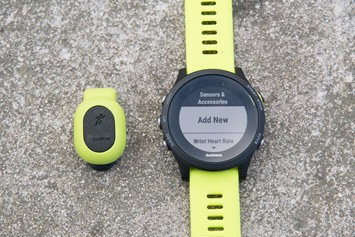

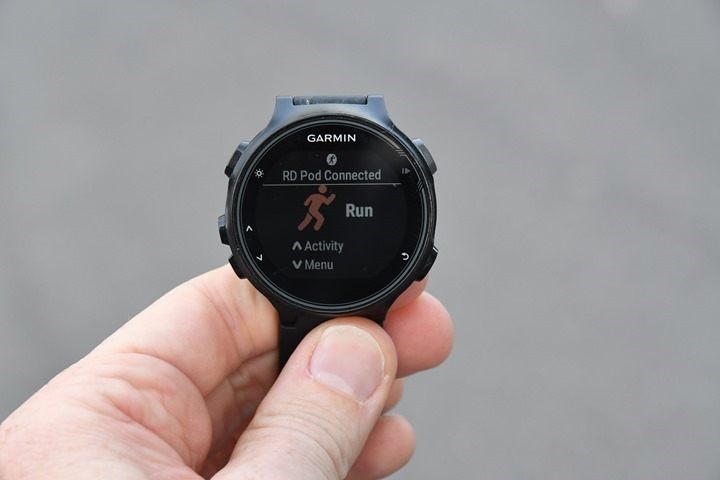
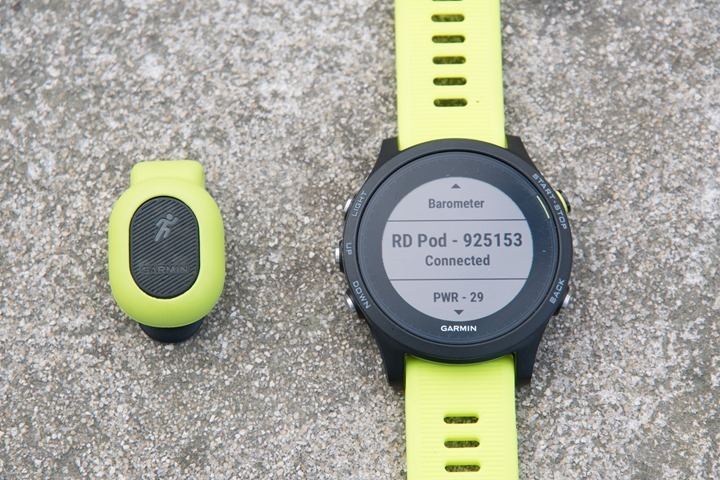



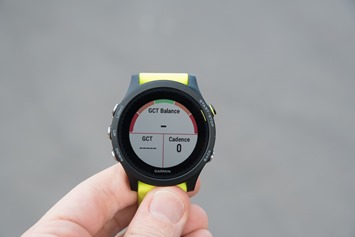
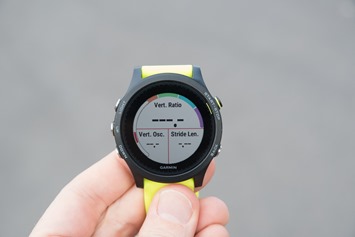
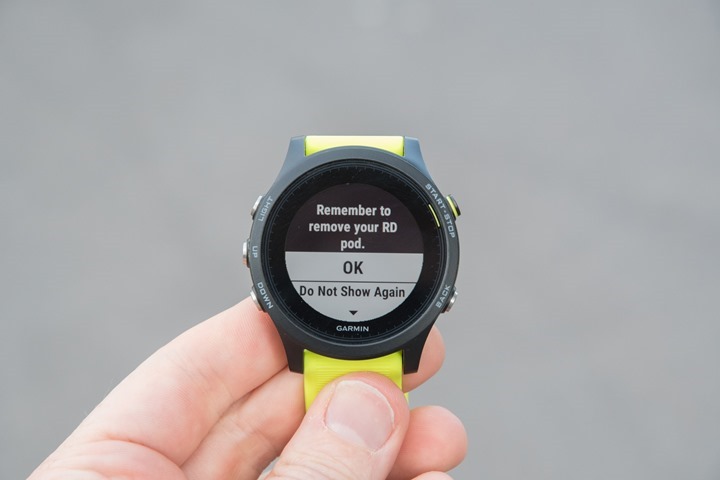
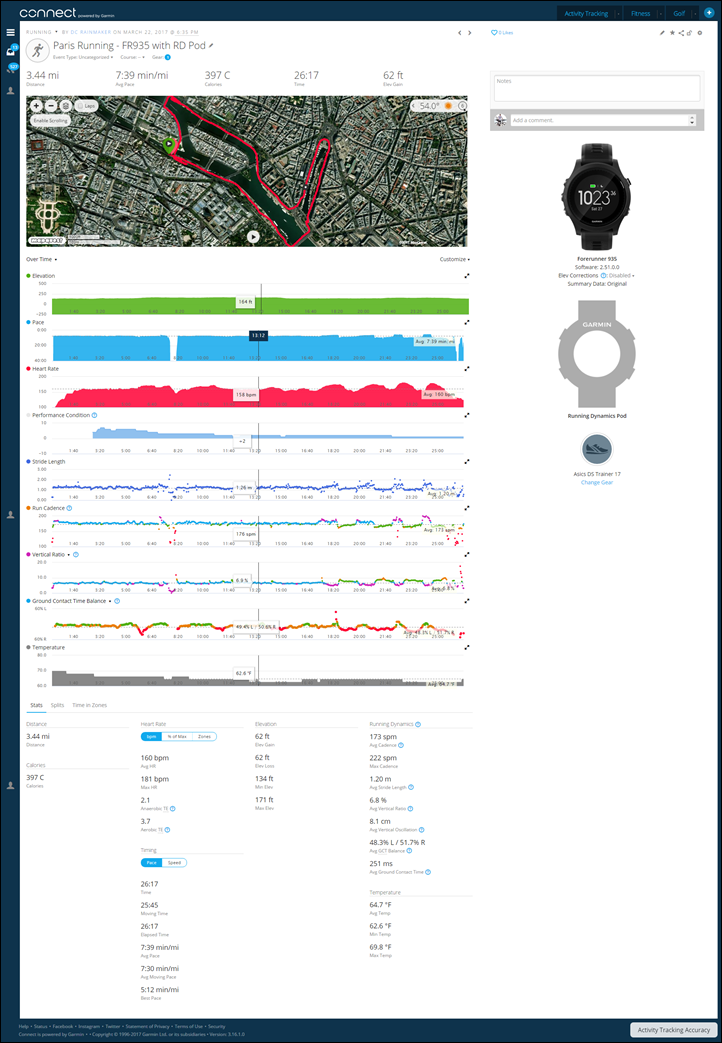


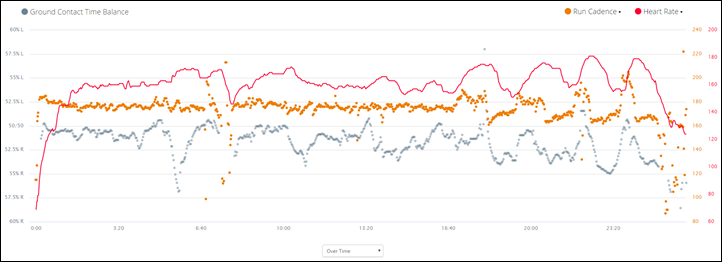

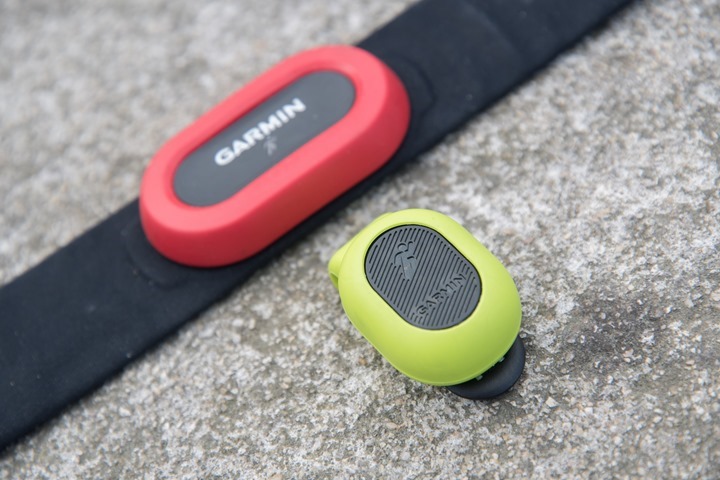
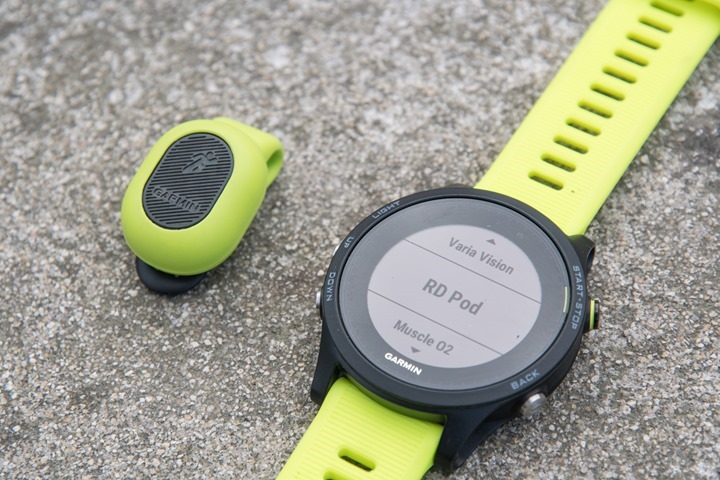
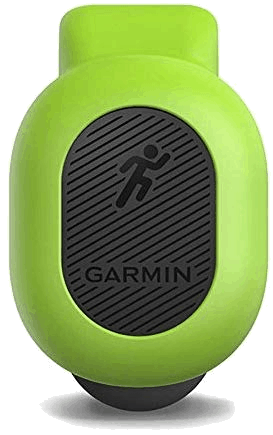

















I wish it could have been a 3 in 1 device…on the back of your shorts could be used for running dynamics. On your foot it could be used as a footpod. On anything you clip it to, it could pick up temps and replace the Tempe. That would be worth the $69 in my opinion. Would have been SO versatile.
I agree – this would be awesome if they could give it a firmware update somehow. In particular I only really *need* a footpod for treadmill distance accuracy, so it’d be cool if it could be used as a footpod for treadmill distance and as a bod-pod for the running dynamics when running outside.
Still, definitely nicer than having it tied to the HRM-Tri or HRM-Run – neither of which is a pool capable strap, and both of the newer version of which can’t be buttoned to other straps, sports bras with the strap built-in: link to mi-pulse.com, or one of these shirts if you prefer them for comfort: link to amazon.com
Yep I agree also. The Tempe is $25, which this should be priced also. $70 for this is nuts. I would def pay $70 for a 3 in 1 tho.
These devices do allow firmware updates although I suspect not to change what they fundamentally are designed to do.
If this measures cadence accurately , and can measure stride length, do you still need a foothold for treadmill workouts?
Add into that, step counts. What if I don’t want to wear my Garmin watch for the day, but would still like to get step counts? Wear the RD pod and pair with GC on the mobile. It’s already doing everything that a watch does during the day to measure steps, right? Seems like it’d be a no brainer, assuming it has any memory to store a bit then synchronize.
I like:
– The size.
– Not bicolor skin if you run shirtless. (big win).
Don´t like:
– No POWER in running. Like the stryd. Come on Garmin….
– No new data.
This thing is a bunch of numbers that mean pretty much nothing, just like the stryd powermeter for running.
type: Just the way I role.
typo, of course – my my…
Thanks!
Gotta agree on the Fenix 3 HR lack o support. I’ve got a 1.5mo watch that would have been nice to have these dynamics available for purchase of pod.
Oh wells….
Did you try it out while riding a bike? You could market Cycling Dynamics ™ metrics that would be invaluable to the data driven rider.
Mmmm. Candy.
I think you nailed it right on the head with the discussion about the puzzling omission of Fenix 3/HR for a list of compatible devices. Hopefully Garmin can address this soon, instead of try and stick with an idea that Fenix3/HR owners will dump their units in favor of spending $700 for a Feninx5 so they can in turn pay another $70 for a pod, just to avoid wearing HR strap.
It is fairly common to announce support for new devices and sometimes add others later. This happened with foot pod support for pace on running watches. I guess if you have a F3 and really wanted RD most people would probably have got themselves a compatible strap. Agree though makes more commercial sense for Garmin to open this up but maybe there are technical limitations we don’t know about it.
Personally – if this worked on my F3 i would fork over the money – i already have the chest strap, but would love to switch to a Scosche arm band.
Ray, you are so crazy with the candy things! 😀 I enjoyed it a lot!
ok, does this seem silly that it is not built into a foot pod? I get the usecase for running dynamics but this will see frequent wash cycles whereas a foot pod is great as I put it there and take it off when I get new shoes or… wear they to the airport 🙂
I have been wearing a heart rate strap for so long it feels weird when on a run without it.
The footpod works for something, but it can’t measure balance (left/right) because it’s not in the right spot. It’d be biased one way or the other.
The problem with it being a footpod would be that it could not measure vertical movement properly. The vertical oscillation measurement is based on how much your whole body, ie. torso, chest, etc is moving up and down. Less oscillation is more efficient running. If it were on a shoe, well then it would measure how much your foot is moving vertically on each stride, which is a lot more than the rest of your body. A good running form will have much more up and down movement of your feet.
Garmin say it measures strides length in the specs. that x cadence =pace. (I appreciate that the gamrin site could be wrong)
This must be a REALLY limited market if it does not give pace as well. People will end up only using it for cadence…which is on the watch anyway.
I am surprised at the accuracy, it must move about quite a bit with the precise position to which it is fastened to clothing. Very variable results I would guess each time??
Yeah, I saw that as well. I’m not sure if it does – or if it just calculates it (my understanding was just calculation). I’ll ask.
I’m going to dig through some of my older RD pod data from earlier in the month as well. I’ve got a few other comparison runs sprinkled about. It’s been a bit messy the last 3-4 weeks because I’d have data from unreleased devices (i.e. Wrist HR, FR935) mixed in with data from announced but not yet published reviews (i.e. Fenix 5), so I’ve got a lot of duplicate data sets I want to consolidate into my analyzer and play with in more detail. Not to mention running out of devices/wrists to capture it all…
hmm. on that issue of data comparisons. Do you ever experience interference in the ohr signal from one ohr device to another?
I appreciate the argument that light can travel through the body and also be inadvertently received by another sensor.
But in the REAL WORLD have you found it to happen? Perhaps recently, for example, if you get my drift?
I’ve seen it happen if one device is too tonight, showed up a while back in some TomTom tests I did initially. Also actually came up on some group runs I did at the ANT+ Symposium with some of the Garmin folks there, talking about they’ve seen it as well. It’s not every time, but it’s just something I’ve made a habit out of not doing nowadays.
Though, the specific concern is actually that one strap is too tight that it impact other sensors on that wrist. Also, that you get ‘bounce’ from one unit (primarily if physically touching).
Heck, even holding a camera/wrist up can trigger it. You can see that at the end of one run in the FR935 post where I was filming an unpublished (soon!) TrainingPeaks video and it was so obvious what was going on, since none of the other intervals I filmed from start to finish that way.
That said, I generally disagree that I shouldn’t be able to hold something light (i.e. a GoPro) and have it impact things. I get a full water bottle for example, that’s much more strain on the wrist. But a gel packet or a phone or a GoPro? Less so. IMHO if the sensor is that sensitive, it’s likely going to fail in other ways.
Just my two cents. Sometimes I’m careful out of an overabundance of caution in terms of just not wanting someone to say I’m doing it wrong or this is impacting that, etc…
Ok, I confirmed with them – it’s (stride length) calculated with data from the watch. That said, they noted it’ll be more accurate because the supporting data is cleaner from the RD Pod.
Would be intersting to know if they still use it to aid pace calculation on the watch. As we know the wrist accelerometer is suspect to lagging every time you raise your wrist. I digged up the hidden speed track with pure wrist data from one of my runs. It’s called speed2 and matches what garmin show on their site and during run. (used omb FIT and custom data tracks plugins in ST3 to get it).
If you use a foot pod the speed data from it will be stored there instead.
Would be interesting to see what the data from run recorded with RD pod looks like.
Do footpods (Garmin or 3rd party) take precedence over this pod for cadence and distance (assuming no GPS like in a tunnel or treadmill)? I know the Garmin footpod gets very accurate and the stryd seems even better even correcting for treadmill peculiarities that others don’t. Thanks Ray.
If a device can measure the same thing (e.g. cadence) then precedence is RD pod, HRM-Run/Tri, foot pod, watch.
Tim/Ray: thanks. I saw Ray said *pace* and distance? are not calculated from the RD pod nor HRM-RUN/TRI. To me what I most want is accurate distance on a treadmill and as a secondary concern accurate real time pace. To allow for this today I wear a Garmin foot pod (and was considering a Stryd). I’m happy to get a RD Pod but will that actually decrease my accuracy for my important metrics or since I don’t see pace listed that will still default back to a footpod even if wearing the Pod.
I’m willing to be a sucker for more numbers but not if the important ones aren’t as accurate. Hopefully I am making some sense…
Thanns
Hmm, where did I say pace? In the video (if so – definitely not purposeful). I don’t see it in the post.
From your post:
“The device has an accelerometer inside, just like the HRM-TRI/HRM-RUN straps did. With that accelerometer it’s able to measure the following metrics:
– Running Cadence
– Vertical Oscillation
– Vertical Ratio
– Ground Contact Time
– Ground Contact Time Balance
Like the HRM-TRI/HRM-RUN, it does *not* measure pace. Unlike those straps though, it doesn’t measure your heart rate (seems obvious, but I figured I’d mention it). Note that your Garmin wearable already measures cadence via the wrist, so this is doubling down on that. It provides what is generally considered higher fidelity cadence data (like a footpod would), since it’s not prone to errors based on wrist movement (i.e. holding a water bottle or a camera).”
So… it does cadence (and has priority over everything for it based on what you and Tim say) but does NOT produce pace. So what does if I am wearing a footpod at the same time as the RD Pod is what I’m getting at? It seems pace / distance is most accurately created by a *footpod* if I’m understanding things correctly and I don’t want to lose that accuracy if I’m wearing the RD Pod. Thanks Ray!
If you are wearing a foot pod and have it paired then there is an option in the sensor entry for it on the 935 to take pace and/or distance from it even if you have GPS. So if you were wearing an RD Pod as well it would not have any bearing on pace because, as mentioned, it does not measure it. In general I would say overall distance is best measured by GPS but current pace stability can be better with a foot pod although pace by GPS generally works well for me and so I never bother with a foot pod for pace outdoors.
Thanks Tim, for me it’s about the treadmill. I want the most accurate measurements on a treadmill. Glad it will still take pace and distance indoors from my footpod when wearing the pod.
Thanks Tim. So it seems that FP used as a “speed” device to measure pace along with the RP and the Watch would give the best permutation for outside running.
I really would have liked to see Fenix 3 compatibility. Would have ordered one today if that was the case, but don’t want to drop a lot of dough on a new watch when the one I have is pretty solid.
What is the waterproofing level? Most importantly, is it sufficient to survive the swim portion of a triathlon so I don’t have to fuss with it during transition? Certainly there are ways to deal with it well during transition, but I’m just curious if I could leave it on under my wetsuit during the swim.
Thanks for the review!
It’s only IPX7 so unfortunately not made to survive a swim
IPX71
Suitable:
Splashes
Rain or Snow
Showering
Incidental exposure to water of up to 1 meter for up to 30 minutes
Unsuitable:
Swimming
Diving into water
Snorkeling or Scuba Diving
High-speed watersports
I understand several have got sent through a washing machine by mistake and survived! That is partly though why the message to take it off was introduced.
“Oh, and Peanut M&M’s.”
Thankfully not Chipotle, for a change! 😉
Would be more accurate on the back of a sports bra? Any chance the girl would like to do an accuracy test as compared to the strap? Thanks!
Good question. I’ll see if I can get The Girl to give it a whirl in the next few days. She’s been pretty sick as of late with the flu, so might be a few.
You can wear the bra. Come on. lol
Ray – Did you ever have The Girl test the run pod on the sports bra for accuracy compared to on the waistband and to the HRM strap? When I wear my run pod (on my waistband), my GCT and vertical oscillation readings are all over the map, but they are relatively consistent when I wear my HRM strap. I’ve tried wearing bottoms with a tighter waistband, which helps a little, but it is still significantly off what my HRM strap shows. I’m thinking it is just not designed for someone with a little “junk in the trunk” (and thus, some extra “bounce”), and was wondering if wearing it on my sports bra might bring the pod readings more in line with the HRM strap?
Ray, I run with a spibelt (carrying my phone). Will this work in front? I suspect there might be interference as I have the phone behind me. Many thanks.
I’ve actually run with a SpiBelt on all my runs – including my phone. Though, I tend to align the phone to my side (hip), since it bounces less there for me.
That said, I’m not aware of any specific issue with being on the front. I’ll try/ask/etc… and find out.
Do you run with your phone during races too?
@Ray – thanks. Looking forward to what you find!
@Brian – I do.
RE: Me and phone
Not generally. I don’t generally run with it either. I just happened to on a few runs lately to capture some other junk on other products.
This video from Garmin specifically states that it shouldn’t be worn at the front or to the side or even facing inwards at the centre back link to youtube.com
@Crispin – many thanks for sharing the Garmin video.
If you have the HRM-Run strap does it still make sense to wear a footpod for treadmill running?
I’d be interested in knowing what is the most accurate.
Also if you wear both do we know if the watch takes the cadence data from the footpod or from the HRM-Run strap?
(note: im asking about the footpod not the RD-pod)
Foot pod measures pace for treadmill and is quite accurate, the HRM-RUN/TRI do not.
The watch measures pace on treadmill but can be in accurate depending on hand movement.
I mentioned the precedence above for cadence – so would use HRM-Run not the foot pod but the RD-Pod would trump both.
Most accurate is a tricky one as it assumes you have a 3rd “definitive” device to compare with and you don’t really. Usually with my RD data I take a view of does this make sense to me based on where am I running (e.g. is there a camber), do I have any “natural” imbalances due to injuries etc etc
Seems way overpriced for useless data. I’ve never heard if any training program that address this data. Great that you have more things to measure but if it doesn’t help you. It seems useless.
The MilestonePod is a much better bargain and serves a purpose – and only $25.
I swear Garmin looks at us as just $$$$
Good point and I think you can get pace on a Garmin watch from the Milestone ?
Note the Milestone pod will transmit pace, but won’t transmit running dynamics stuffs to a Garmin device.
As noted in the post, not sure I see the value – but…to each their own.
I do see the value in Milestone, though also seeing a few things concern me that I’m getting clarified soon.
MilestonePod has a host of other “metrics” which Im not sure are much more valuable. I think foot strike is actually useful in helping with shoe selection. Also allows you to easily track miles on a shoe But then again it’s only $25. I use it as a backup.
“Note the Milestone pod will transmit pace, but won’t transmit running dynamics stuffs to a Garmin device.”
The only 2 devices this is true for is 935 and fenix 5, as it transmits in blte, correct?
Also
Everyone keeps saying, “shucks too bad f3/3hr arent included” and I am over here like hell, why isn’t the f2 included? F2 supports running dynamics. When was the last time I got an update ¯\_(ツ)_/¯
This would be an easy one. Throw me a bone here Garmin!
Correct, only those two devices support BLE sensors (which is what Milestone pod is).
I’ve got a MilestonePod – pace stability on a treadmill wasn’t great TBH. Stryd or Garmin foot pod much better in that regard but, as stated, the RD Pod isn’t really a comparable device – you would need both really in some situations if you wanted all these metrics.
Does the Fenix Chronos support BLE sensors too? I thought it got all the features of the 935 and Fenix 5?
Ray, you said a month or so back…. “I do see the value in Milestone, though also seeing a few things concern me that I’m getting clarified soon.”
Any update on that or further thoughts on the milestone pod generally?
The quick and dirty version because I’m really far behind on this:
A) Accuracy/compatibility/general happiness: All good, a solid buy.
B) The thing I was concerned about…
I found out that Milestone plans to make money by selling your specific data to retailers. Not a generalized data, but actually you as a person to a retailer, so said retailer can target you as a person for shoes based on mileage or pronation/etc…. Except they don’t disclose this anywhere. So when you created the account it was saving all this information – which is why they asked for your shoe model. They then tie this to the pod ID from the retailer you bought it from, which allows them all the PII information they need to complete the circuit and pitch your data back to that same retailer.
They’ve been pitching this to retailers (and then charging them a fee per user per month), but retailers I’ve spoken with don’t believe it’s worth the cost, let alone their (pretty high) concerns on the privacy pieces. Others noted that this would actually be more logical for someone like Amazon to work with on. I’d actually be happy to have my usual shoes re-ordered every few month when I hit 400 miles. But I ****NEED**** to be in control of this 100%. Not some fly by night thing behind the scenes without my consent.
The funny part here? The company says if you buy from Amazon – they aren’t do any tracking there. So…I suppose the answer is to buy from Amazon.
For the record – I did approach Milestone about this, and they tried to backtrack a bit on it all saying it hadn’t been executed yet. But their backtracking simply doesn’t line up. They said they were doing generalized non-PII data. But that’s not true, because they told retailers they’d get specific peoples names/users. With that, the retailer has no value for the data since they wouldn’t know who to pitch to what. And without value, the retailer isn’t going to pay what was already a pricey fee per month per user.
Anyway…
Thanks for the detailed reply. I’m looking for a cheapish pod to do pace/cadence/distance outdoors and treadmill, and the Milestone seemed an interesting alternative to the Garmin footpod, with the bonus of some potentially interesting running dynamics data thrown in. Sadly Stryd is out of my league.
What you write is a bit concerning. I did read the bit on their website:
link to milestonepod.com
…but I took this to be the potential for some kind of promotional activity. I.e. a company could give these out for free and then get the data in return. I didn’t think it would apply to normally purchased units. Hmm, very confusing, and they shoudl clarify.
For pure foot pod pace/cadence/distance accuracy and reliability, and ignoring the marketing issue, which would you recommend for use with a Fenix 5?
It was/is planned for purchased units, not promo. It’s their business model and how they planned to stay in business – by having the retailer subsidize the cost of the device. In the wording on that site you see “Your customers get an almost free” – meaning, the customer is paying for it.
That said, don’t get me wrong. Buy it from Amazon and enjoy it. I think it’s great, and works just fine with the Fenix 5/FR935.
Been doing some more reading and realised it’s right there in the privacy policy on their website:
link to milestonepod.com
Your Retailer and other Retailers. By using the App together with the MilestonePod, you explicitly agree that we may share some or all of the information (including Personal Information) that we collect from you with the retailers from which you bought or received your MilestonePod or subject to your approval, also to other retailers.
Not really great. I have also asked them about this. But still tempting to be honest given the price.
Yeah, it’s there now. It wasn’t there previously. They changed it after I brought it up a few months back.
Here’s the previous snapshotted version: link to web.archive.org
Typical Garmin. Hope they made it compatible with Fenix 3 / 3 HR. I’ll buy the pod in heart beat. Hoping Wahoo , step their game and move to wearable GPS. And Knock Garmin down. Since Suunto , always play catch up.
Hi Ray,
Remembering your ‘Riddle Me This’ running efficiency… rant- will you be posting any more accuracy comparisons? Can I assume you might be working on this but may be waiting for some embargos to end before releasing results?
Indeed, was mostly waiting to get through the FR935/RD pod stuff, since much of my data has been tied up in some of that.
I like your *sweet* size comparisons in this review. However, I notice you use a digital scale for weight but not a ruler for dimensions. Why? Lastly, and in that vein, what is the M&M weight of this new RD pod?
I actually have a fancy doohicky for measuring things (technically it’s for measuring bullets)…but…I can’t seem to figure out where I put it.
As for the M&M weight…regrettably, I ate them all.
You amazon link seems to be 404.
When running with a stroller, would this unit not only show accurate cadence data but also track your step count within the daily activity tracker? I’m a data geek and I end up pushing the stroller one handed to ensure the other arm is swinging to get “credit” for my steps.
I’ve always found that I’m much faster and more efficient when running with a stroller to push with one hand, and off to the side so that my feet cleared the stroller/wheels on longer strides.
I adjusted the bicycle style hand brake off center and at an angle so that my stroller hand rested comfortably on it without have to grip it, but still being easy to grab the brake, if necessary.
With my free arm, I swung the hand a little more than usual, to help with the lack of work the other shoulder was doing.
Some of my fastest runs ever were pushing a double-stroller, perhaps because I was so mindful of my running form.
Well would certainly help in getting more consistent cadence data if it was otherwise coming from a watch on your wrist with inconsistent swing patterns. Are you recording these stroller runs as normal activities – i.e. start timer? If so how does cadence look in these?
I swear my son’s first word was “faster” when I was jogging with him in the stroller. I use a dog running leash attached to the stroller handle to make sure I’m ‘connected’ to the stroller, but still allow some running room.
I’ve been focusing on my cadence over pace lately, but haven’t run with the stroller since the change. Will be interested in this as well.
I’m also interested in this!
Hi Ray, I’ve been relying on your site for years but this is my first time commenting! First off, thanks for yet another thorough review. Second, I’m wondering if you’ll consider making one of your fancy side-by-side comparison charts for this and the Stryd, Lumo, and/or other comparable products. I’m suddenly overwhelmed by the number of options. Maybe you’ve already done this but I wasn’t able to find it after a quick search of your site.
Oddly enough – if you check out the link towards the end for my running efficiency metrics, I do have some comparative data tables in there. 🙂
I haven’t put the RD pod in there, though, the metrics are the same as the HRM-TRI/RUN of course. I still need to add in Lumo though.
Maybe add a shot of the old foot pod and the new RD pod for size comparison? And a shot of how it’s recommended to be worn?
The RD-Pod is significantly smaller than a Garmin foot pod although of course that is hardly massive. Back of shorts in the middle is about the crux of it.
The new pod looks like the original Stryd Pod
Ray,
I don’t see a comparison weight to the Werther’s Original in here. Huge oversight.
I actually weighed it, it was either 3 or 5g. Much lighter than I expected. 🙂
But which is it?! I can’t buy it if it’s 5 grams! I mean I could understand 4.7 grams, but 5?!
Ugh, useless. Unsubscribed. Unfollowed.
Lol love you both 🙂
Hey guys am I the only here to think that the 920xt is also an obvious miss?
Great review as always, although a not so exciting product.
I’ll second that. I picked up a 920XT when they got cheap in the run-up to the 935. Very fond of it, and the newer watch is not in the budget at present.
Objectively, Ray is almost certainly right: Nobody really seems to have any idea what to do with any of this running dynamics info — from Garmin or anybody else, I suspect. The hardware/software package is just ahead of the science. There may be potential here, but we probably don’t even know which metrics matter yet.
That said, I’ve always been a little frustrated that I couldn’t get the running dynamics info (geeking out on this stuff is half the fun, right?) without a chest strap, which I’m not going to wear. This device resolves that, but not (yet) for 920XT or Fenix 3 users.
It’s a tad pricey relative to a normal footpod, but I’d probably go for it. Garmin has thus far been pretty decent about supporting updates, and I believe the 920XT did very well in the market (so there’s potential cash on the table here). Don’t see any obvious hardware or software issue (same basic setup as the RD enabled HR strap), so I’m guessing there’s hope. But I haven’t followed the market closely enough to really have a good handle on Garmin practice. Anybody have a better idea about the likelihood that Fenix 3 and 920XT users will get the nod?
Garmin – Please update Fenix 3 / 3HR to work with this. I gave up running dynamics in favour of an aftermarket optical HR device because I grew to hate chest straps. I would buy this to bring that functionality back. You have been great at keeping the F3 fresh and up to date with firmware upgrades, I get you wont give new features to them that give people a reason to buy the F5 / FR935 but this is not new functionality.
Thanks Ray – nice article as always.
Great review as usual Ray.
Only issue is that this is just another device that provides data that no one know what to do with anyway. Whenever I wear my HRM-Run I look at the Advanced Running Metrics for about a second before I move on to use data I know I can analyze and know what to do with.
Anyone thinking about buying this pod, save up a little more cash and buy a Stryd foot pod. You get some of the same types of metrics (GCT, VO, but not Balance) but then get Power Data, LSS, Form Power as well as a very accurate foot pod all that can actually be used to evaluate and design your training.
yeah this is mainly to get RD data if you don’t have a strap or don’t care to use one. So if you have checked out RD data before it is all the same stuff again but from a different source of course. You can however use a Stryd and this and get even more data to muse over!
Tim, only metric I see that I do not get, or cannot calculate from Stryd Data is the L/R Balance. Other than that I get everything from Stryd (although do not know what to do with most of it).
I will say that when I was using it to compare some data between my coach and me with Power Data, VO was one area where I could see relative differences (VO/Stride Length) so as a secondary metric VO or GCT can be useful possibly, but not as primary training metrics, at least for me.
Left/right balance is actually the one metric I “watch” the most. It is a good test of what my sore left Achilles is doing and whether I am wanting to avoid putting weight through it or not.
Tim, agree in circumstances where you have an injury or even just to check in peridically. The main issue with that metric si that I have found running rural roads (at least in the US) that have high crowns for runoff purposes, this metric is affected by this and not really representative of any biomechanical imbalance, just a measure of the conditions.
@Tim Grose I hear you Tim. Is the one metric I care about. I understand it might not be 100% valid, and it can be inconsistent. And as Ray mentioned in his video, maybe balance is off, and switching to equal could impact you. All that said, as I’ve battled plantars issues (thankfully no surgery for a partial tear, but a regenerative injection treatment schedule for next week). I like the L/R balance to know or try and understand if I am favoring one leg/foot. In the course of an Ultra, such data could be useful to know if I’m losing some efficiency or wasting energy or something.
Excellent point.
I think for cadence it’s enough to have an average at the end of a run which the watch is good enough for.
I also generally just use lap pace (based on 1km auto splits) for speed.
Left/Right balance on the other hand could be very useful for injury prevention, when having a dull pain or tendinitis in this foot or that knee, hip, … if the balance is off too much it’s time to take a break from running. It would be the number 1 reason for me to get one of these.
So stick with my Foot Pod is what I’m taking from this, I have NFI of what to do with all the other metrics and I use the Foot Pod to smooth / correct my cadence for treadmill etc because the wrist based unit has to put up with me looking at my watch,changes in arm swing etc.
Will the RD pod measure Lactate threshold with fenix 5 without HRM strap? Thanks for the info
No, that requires a chest strap today.
I was suprised to notice it actually does measure lactate treshold with a fenix 5s without a chest strap, when I use my Scosche optical HRM.
Reviews foot pod. Doesn’t have one photo of how/where to mount it…
He shows in the video – you put it on the back of your shorts.
Reads review. Doesn’t notice it’s not a footpod.
Nice review, like to pod a lot.
Though it doesn’t make sense for it not compatible with fenix 3/3 hr, too bad.
Hope The Girl is feeling better. RD, kind of like an old English author’s “Much Ado About Nothing”.
Keep up the good work. With all this body metrics data I have yet to see any improvement in local race times, for runners so equipped.
Hmm – great idea – but without the HRM-RUN equivalent HR – you loose all the recovery stats etc?
The built in Optical HR does not give you the advanced HR related data as far as I read the specs.
So Watch + Pod = less data than Watch plus real HRM-*
The only watches that the RD currently supports are ones with optical HR built in so recovery time, VO2Max, and heart rate recovery (waiting 2 minutes after stopping before saving) will all still work.
The only things that will be affected by using the RD Pod in combination with the built in HR would be metrics that require HRV/R-R data that oHRM doesn’t provide. Currently that would be Stress Test, LTHR, and maybe Performance Condition. For those you will need the chest strap.
Good review! I disagree that these running dynamics data have no value. I searched a bit when I started using it on my F3, and some of them are actually quite useable and “actionable” –
Vertical oscillation / ration – obviously you want as less as possible vertical movement. You can control it by leaning a bit forward to the point beyond your center of mass. It seems to be recommended by professional trainers (at least from what I googled). Watch data can give you an indication how well you improve on that, and from my humble experience it does make some difference and leads to less impact on the knees. Just google something like “run vertical oscillation”.
GCT balance – After long runs on which the watch said I wasn’t very balanced, e.g. 47-53, I felt pain in the knee of the leg that had more pressure (not always the same leg). How do you improve it? I didn’t do a research but from my (again small) experience – indeed trying to force weight to some leg doesn’t really help. What helps is making smaller steps in a higher cadence.
Anyway indeed could’ve been useful if Garmin would write their own recommendation and explanations regarding on how to use this data, but till then people can google exploit it by themselves.
Ray, given the fair accuracy of the 935 / F5 optical heart rate monitor as compared to chest strap and this new pod offering, what is your and Garmin’s perspective of using optical heart rate to measure all the related performance metrics like VO2 max, LTHR, Recovery Time, Training Effect, etc.? Good enough during runs maybe not cycling? Thanks!
Absolutely useless.
I haven’t met a Run couch inquiring about this data nor any athlete referring to the above data.
They should have thrown a Tempe sensor in there to make the purchase more enticing.
Totally agree! A full multi-sensor foot pod is where they should have gone. Just add Tempe to a better footpod that gives all these metrics and that would have been something I might have considered, although I don’t have any footpod space left with Stryd and Milestone pods 🙂
Well except Eran above.
Watch this link to youtube.com
Got me thinking about this stuff some more…
Well… Except Eran is wrong about VO and his comment regarding lowest value is best. As we both know there is an optimal VO for a person and a pace that maximizes LSS and subsequently the running efficiency at that pace for that person. Try shuffling your feet with no VO and report back how much more efficient your runs are ;).
Funny you referenced the Gliders / Gazelles video, I have spent some time reviewing that material and seeing how it might apply to me. I tend more toward Glider. Stryd was doing a study on this to see if they could come to some conclusions on this and I have not seen the results yet. Do you know if they completed that work?
Not seen anything there from Stryd. I think at the time I did remark that I must have been a “gazelle” when could operate under 4:00 min/mile pace for 2 laps of the track but these days not so good!
Isnt it possible/likely that with the RD pod attached to the back of your shorts, you are likely to get excess body heat registered on the device. the tempe, I thought, was recommended to be somewhat away to avoid to much body heat.
“Nor, is it a candy to eat (a mistake I almost made a moment ago while eating some of those Maltesers in a small pile next to my laptop).”
See, now i’m just curious as to whether it would still work to measure dynamics when consumed – think of the aerodynamic advantage of it not being attached to your shorts!
Soo, i’ve been considering buying a footpod as i’m getting stuck indoors more than i would like (and i currently have a 735xt).
Would this be more accurate than the built in capability on the 735 for Tmill runs (basically the reason i was considering a foot pod) and the rest of the metrics are gravy?
No – it is not a foot pod – it does not attempt to measure your pace.
Good afternoon¡¡¡
Thanks for your videos and yours reviews
I need to know, the rd pood is the best system for the indoor activities??
Thanks in advanced
Damn, it would be the perfect add on for the FR 235 (Running Dynamics!!!). It would justify the insane price here.
Too bad they didn’t put a pedometer/sleep monitor functions into it. Would have been a whole new use case. Some days you just wanna wear a normal watch and not geek out.
What’s this you say? Additional data! I’ll have it! Not compatible with Fenix 3 you say? Never mind then!
Disappointed as an FR235 owner. I hoped for a compatible running dynamics pod.
Wouldn’t an CONNECT IQ-app be able to present/store this data or is the data stream from the pod not available for app developers?
Harsh reality: the 235 has been out 2 years and never supported running dynamics, even if you bought a $100+ HRM-RUN or HRM-TRI strap so Garmin was never going to add it now.
Hopeful wish? The downmarket replacement of the 235 likely due this year may add running dynamics as a new feature in that price class?
They should’ve called it “pants pod” because quite literally that’s what it is, and not just meaning where it’s attached. 😉 Stryd or even a milestone pod over this any time.
I find it interesting that folks compare to Stryd. Stryd is great, but it’s also three times the cost.
Milestone is great, and 1/3rd the cost, except that it’s Bluetooth Smart only and you can’t export minute by minute data for these additional metrics.
So comparing the three is a bit weird.
I guess people (myself included) were hoping Garmin would introduce something new and interesting.
It’s a good thing the RD pod is at least not expensive.
To me the milestone pod is interesting because newer watches support BT and I could (probably?) use it as a low cost footpod spare with some added value.
Bonjour,
Peut on espérer que Garmin via une mise à jour nous donne la puissance (comme le premier pod stryd)?
Salut Laurent,
j’ai peur qu’en français tu n’aies pas de réponse (mais on ne sait jamais).
Hello, May on hope that Garmin via an update we give (as the first pod stryd) power?
Thank you for the great review! Too bad about Fenix3HR I would have already ordered, but not going to get a new watch just for it. Thank you again for the awesome reviews!!
Have you seen, heard of, or used the Lumo Run? Same thing but not garmin. Just curious
Yup, I’ve talked about it a little in the past: link to dcrainmaker.com
Wow no Forerunner 630 compatibility? Like you said DC, that’s leaving money on the table. I would have scooped one up. I guess I will be giving my cash to the Milestone Pod instead of Garmin.
Totally agree on silly for no FR630.
That said, not sure what Milestone would get you here? The RD Pod isn’t a footpod that does pace (which the Milestone pod does). Inversely, the Milestone pod doesn’t transmit running dynamics over BLE. So basically the only thing one could get in this equation is slightly more stable cadence data.
You are correct about both Pods. But I thought this blog was about you showing us stuff none of us “really” need. In turn we will give companies our currency so we can have a vehicle to obtain metrics we wont understand, know how to correct or even if it needs to be corrected.
Everyone loves fancy colored graphs.
The 735,935 & 5 all run Biker Monkey (CIQ 2), whereas the 3 runs Aikido Monkey (CIQ 1).
So that will be why the fenix 3 is not compatible.
I guess this demonstrates Garmin’s stated policy to not do any more development work on Aikido. The
same will happen to Biker, as they have a two year life cycle.
I just purchased the (much) cheaper 3 because I found the HRM of the 5 a work of fiction.
Rob.
and the 630 is also Aikido Monkey (CIQ 1), so that will not get the update, I guess.
Rob.
I wouldn’t tie together CIQ updates with RD Pod compatibility.
CIQ updates is more closely tied to hardware capabilities, versus RD/sensor compatibility is more tied to business objectives.
Separating the RD from the (chest) HRM would make sense if their wrist sensor wasn’t a random number generator.
Does this measure stride length as well? With a Fenix 3 HR, I get stride length in non-running activities (hiking, mountaineering, etc) when I wear an HRM-Run but not with just the watch. This has been pretty valuable for cross country skiing. I’m working on my technique to maximize glide. I wish I had this when I bought my skis, it would have made comparing different ones easier.
I like the idea of being able to access this data from something other than the HR strap, since my strap seems to a real pain to wear while running during the warmer months.
And while I am one of the people who benefits from the left/right foot balance data (a two-time torn left ACL has made me limp while running, especially at slower speeds), I can’t see buying this pod. I think the unit is much too small for practical use–I can guarantee I would lose the unit within one month of purchase. Love the idea, but I don’t think the product is practical.
Just as an interesting tidbit for folks following along in the comments… As of yesterday, Running Dynamics is now an ANT+ standard (and thus, now lower-case running dynamics). Here’s all the details on it, and what it means for 3rd parties: link to dcrainmaker.com
Thanks for this and all the great reviews Ray. A couple of questions on this pod.
1) What do you expect the battery impact to be on the F5x when an extra sensor like this PD is connected. If I use the F5x for an ultra, and wanted to use the POD as well, do you think the extra battery usage is significant or insignificant?
2) now that the Running Dynamics is made ANT standard, what do you think that will do to the common view that many of these metrics do not have considerable value. Might we see more usage for these metrics become apparent?
thanks. as I bought my F5x on CT, I’ve got a $69 credit. so this POD would only cost me $0.99. I think I might bite on it, at that level
1) No impact to battery life. I tested it once on some other older products, and it was less than 1% battery impact to enable ANT+ sensor recording (of any type).
2) I think we’ll see some progress, but it’s still going to take 3rd party platforms actually showing them (beyond a few smaller platforms).
And thanks for the support via CT!
I bet that if you hang the pod on the HR-Run strap itself (on your back, of course, exactly opposite from the HR-Run transmitter) you would get as close as to exact duplicate data as possible. On transmitter hanging on your torso and another on your waist could easily favor discrepancy between the two sources. Give it a go and let’s us know 🙂
I’v worn the Garmin RD pod yesterday during the Rotterdam marathon. As I am a slow runner I was worried the pod would cause chafting. But none whatsoever! I’ve placed the pod on the back of my capri. Unfortunately the pod covered the zipper of the little pocket at the back of my capri. As I carry a drinking vest and no bra, I can’t test placement on a sports-bra. I do see a difference in data between the HRM-RUN strap and the pod: the GTC balance seems more even with the pod than with the band. I guess my breast surgery operation have something to do how I turn my torso. I’ll have to use the RD pod on familiair routes to make a better comparison of the data.
Ps. for The REAL Tim: I did not loose the RD pod during a visit to dixiland. After my run I placed the pod on my shoes, so I would not loose it.
As crazy as it sounds, there’s evidence pointing to the fact that foot pods are significantly more accurate in measuring distance & pace than are GPS watches. In fact, GPS watch accuracy have been getting worse (!) over the years because of design decisions to improve battery life.
Take a look at Jonathan Savage’s blog where he’s been collecting lots of data using various controls to get an apples-to-apples comparison: link to fellrnr.com
Even though Stryd was built to measure power, it turns out that it could be the ultimate in distance/pace accuracy.
Maybe its time to ditch GPS and go back to footpods…
It’s always perplexing people keep pointing to that, since it’s so easy to disprove. Yes, footpods can be great in trees for pace stability compared to GPS.
But one only need to do an interval workout to see where it starts to slide. Footpods are great for pace stability at your core paces, but if you go too far out, it starts to become non-aligned. Not horribly, usually a few percent or so, but that’s generally more than GPS pace/distance is (at least in non-tree environments).
As for the data there, there’s so many issues that have been identified (such as using smart recording in trees on Garmin devices or merely cutting up the same short course over and over again into smaller pieces to make it look like more data), there’s not much value in it. If the root of the data collection is flawed, then no amount of well-made charts make it better.
Jonathan’s #11 on the page to which I linked shows that there is practically no correlation between Stryd’s accuracy and pace. That said, you might be right that accuracy could be effected by quick changes of pace. It would be pretty easy to test, but I don’t have access to the footpods here in Bali.
Maybe you can get out the measuring wheel to lay down a course, mark some visual milestones whereby you dramatically change your pace, get a lap split at each milestone, repeat this a few times, and then review the data? Stryd might be using some sort of power algorithm in conjunction with the other data to more accurately calculate real-time pace.
It would be really interesting to know for sure. If the foot pods are better than GPS it will have a profound impact on future products.
Yup, I’ve gotta run some numbers on Stryd’s distance vs GPS distances. And more specifically, do so across varied terrain and paces. However in a crapton of testing with all footpods previous to this (which are almost all made by Dayton and Dynastream, albeit under various branding) – pace has definitely been a factor in accuracy.
Again, not a lot – 1-2% typically. But that’s often more than GPS is.
Ultimately though, I don’t suspect this will matter than the vast majority of the running market, since for most people (i.e. outside a small slice here or trail runners), GPS pacing in road running environments is ‘good enough’, especially when companies use smoothing as many already do.
Thanks for the follow up. When I move back to the States this summer, I will do some controlled testing and post here.
GPS’ battery consumption is at odds with miniaturization. If low-power sensors can match/beat GPS accuracy, then battery range anxiety will be a thing of the past for endurance athletes…at least until we start stuffing these things with cellular radios…
I run with Stryd. I’ve also tested it against a TicWatch S with various running apps. Also compared it to Vivoactive HR. In my experience, the instant pace on it (pairing it to a smart phone and some running app) vs TicWatch S was no comparison. Vivoactive HR fares much better against the TicWatch, but often times, I find it lagging my real pace by 30 seconds per mile. I know this because I check my pace on it, and then check my actual mile split. From my estimation, it often just lags. It doesn’t make any sense, though, since the distance it reports for the mile markers are really accurate (around 1%). You figure it would get better at pacing as you run further into a mile.
Anyways, I was just wondering. Are GPS sports watches generally like this for instant pace? Do they all just kinda suck? Which is the best one you’ve found for reporting instant pace? I think Stryd is much better in that regard, but it’s not perfect either. Even on the treadmill, I find the pace fluctuates quite a bit even when I’m running nearly in place at 0% incline and a slow steady pace. On the roads, though, it just hops around quite a lot. Although, I figure the ballpark reading is close to my actual pace. GPS watches, though, is just a crap shoot.
Hi. I’ve had a long line of Garmin devices. Recently F2, F3, now F5x. I used HRM straps for a long time, until I had trouble with chaffing, and gave it up for awhile. In the “time off” from straps, I grew away from needing that HR data, but still like some of the running dynamics data. Not hard core on it, but very interesting. Specifically ground contact L/R balance. So I started wearing the (blue) HRMtri strap (using 3M micropore tape to avoid the chaff). So I should be happy. Except I stop “liking” wearing the strap. so I ordered this pod from CT. It should come today. But in the past few days I’ve been reading alot on the stryd. And its got me very interested. More data than I believe I care for. It doesnt have the ground contact balance. but having use running by HR in the past, to running with RPE these days, perhaps running with power is next. I dont get all the data, but running with power sounds like using RPE (Rate of Perceived Exertion) , but the power data to back up that RPE. Sorta. Also in the back of my mind is the moderate ticked off feeling finishing a 50mile ultra and ending 46miles to 52miles at completion It would be nice to have more accurate distance. Dont really need accurate pace, I look at it, and sometime slow down if its high + RPE being high.
so there is not yet one Pod to rule them all. But if you had to put your $$ in one. Would it be the garmin pod or the stryd (big $$ diffference I know).
Thanks for a great review as always.
One quick question (and I think it is a long short, but I’ll ask anyway), does it work with Garmin 920xt? (I initially bought the tri-bundle. I kind of use optical HR and broadcast to the 920xt now, so this pod would complete things)
In the video, when you show the 2 activities (one registered with FR 935 and the other one with Fenix 5), the elevation stats are quite different. For example, FR 935 shows max elevation 171 feet, and Fenix 5 shows max elevation 100 feet. Google tells me that 70 feet means 21 meters. Why is such a big difference? As both of the 2 watches have barometer.
It’s likely the case that set the altitude in the Fenix 5 at some point at the DCR Studio, but likely didn’t do so for the FR935.
The real value of the RD pod for me is the decoupling of dynamics and HR-strap.
Now we can just go buy cheap 17$ ANT+ strap-onlies and toss them after a few months when they start to produce erratic data (unless of course oHR works for lucky you!), which was not really an option with the 85$ HRM4…
I hoped that the new RD POD would support the V3 of running dynamics, but I see this is not the case. It’s still the same old metrics and also pace is not meassured by the RD POD.
I was thinking of getting a whole bundle from Garmin (FR935+RD POD+HRM4 Run), but I would be unhappy if there was anything around the corner that would support running dynamics 3. Any gossips around? I was thinking of FR935+Stryd pod as a safe solution and wait for HRM5 Run.
I’m a little surprised by how many commenters seem to be ready to dismiss the RD stats as useless. It’s not terribly surprising that not many running coaches rely on them, because most current coaches undoubtedly came of age at a time when these kinds of stats were not readily available. As a long-time runner who has never had professional coaching, it just intuitively seems to me that the RD stats provide a useful window into running efficiency and form, and possibly the roots of injury. I expect we will see a lot more research on the questions as more and more data becomes available.
Unfortunately, after only two runs with the RD pod, it disappeared from the back of my shorts on the third run. Felt tight enough to be secure, but I guess not.
I would buy this device in a heartbeat if I could get lactate threshold and HRV stress test using the optical heart rate. Is the issue with the quality of the optical data, or does Garmin want people to buy the watch, pod, and chest strap?
I have noticed after several weeks of using the RD pod that if it isn’t perfectly centered on my shorts, perfectly vertical, and my shorts aren’t centered on my waist, it will skew the ground contact time balance to one side by over a percent. I noticed that when looking at a run and saw halfway through it where it went from 50 to 48.8 L and realized that was where I visited the port-a-jon.
Just for me !! I own an 735XT and a Fenix 5 but I hate straps in my chest.Ok , it would be great to have and temperature for the 735 , but it is ok and as it is .Thanks for the review !!
Hello Ray, maybe there is a way to discuss online how all this running metrix can be used to become a better runner. For example: Lumo is not bad, since they give data, benchmarks and excerises on how to improve, with the Garmin data, I dont know at all what to do, except trainings effect, recovery time and vo2 max. BHX Insight, bought it, but dont find it useful. A race result does the same, since they dont provide a full profile like a lab test. I find the HRV4 app very helpful to give an additional hint on can I do a hard training or just take it easy. Especially since I travel a lot between Mexico and Europe. Stryd, dont know, but seems to be good since powermeter is a standard in cycling. Would like to hear opinions. What I dont like is the implementation first in the HR strap and now foot pod. Like the original idea to use it like the Lumo sensor or Garmin – just stick it to my shorts. Would be great if you can arrange such a discussion forum for runner who want to get faster. Thanks, Peter
Ray, I was thinking more about the sensor topic. We could start the discussion with a table like:
1) Which metrics improves running performance? for example: Cadence
2) What is the evidence that the metrics improves performance? Many studies show the relationshipe between cadence and running economy and performance.
3) What is a value range as a benchmark? Around 180
4) Which sensor(s) are measuring cadence?
5) How can I improve cadence and the metrics?
Another interesting metrics is leg lift. I think only the Milestone pod measures this one. Only mention it, dont have one (yet) and they dont pay me 😉
Peter
Following. Interested to see if this comes to the 920XT. My Run HR broke and I don’t want to replace it if the RD Pod will work in the near future.
I like the pod, but it is very small and I am afraid I will misplace it one day. I would have wanted a small hole in it to make it possible to attach a strap or a band.
I always having problem getting the right cadence on FR235 from my arm swing. sometimes it drop to half of the real value and that make my pace on treadmill totally wrong since FR235 get indoor running pace from arm swing. I also cannot use foodpod since I run barefoot. would using this RD pod solve my treadmill cadence/pace problem? but as you mentioned it only measure cadence not pace. Thanks
get my pod today, will see how it works. Think a good thing, it occurs starting running without hrm-tri, hope i have the pod always with me. It is a drawback to wrist hr measurement, but if the wrist band is tight i think will be ok.
Great summation article on the running dynamics pod, and I actually love all your editorials on Garmin products – so thank you!
My only criticism has nothing to do with your article since you were very upfront in admitting that you lack clarity regarding how to use the data.
Unfortunately, in my opinion, that is the most important downfall regarding this product since you are not alone. I have communicated to Garmin that if they want to sell 10x more HRM bands and dynamic pods, they should provide a video or article that focuses on how to interpret and utilize the data generated from all the metrics captured.
If runners had a greater understanding about how they could analyze and utilize this data to learn more about their body, their running style, or even better – actions they could take as a result to improve upon shortcomings identified, then Garmin’s consumers could much more easily justify buying dynamic pods based on value instead of just price, convenience and comfort.
I 100% agree!
But first of all I want to congratulate DC Rainmaker for his absolutely amazing reviews, better by 2 orders of magnitude than anything you can find out there!!!
Back to the point… I have in fact already spent a couple of hours looking for a good explanation of the GCT balance (i.e. higher % on the LEFT means indulging longer on the LEGT foot possibly indicating a dominant/stronger RIGHT leg… or maybe the other way around???) and how to correct/improve it (balance and strength exercises such as single leg squats?).
I’m currently suffering from a left knee issue and have been told not to run, but if I do attempt one the GCT shows a greater percentage for the right side, such as 40.3%/59.7%. I’m reading that as the right leg doing more of the work.
How do I turn on the reminder to remove the pod? I answered the “Do Not Show Again” question yes, thinking it meant “just this run” and it apparently meant forever. Now I don’t get the reminder. Please help before I put it through the washing machine!
Thank you.
Hi
I just got the RD pod to be able to skip the HR strap. However I cant get it to register any data. It connects to my watch but thats about it. Zero RD pod data is to be seen on the data pages on the watch and nothing turns up on Connect except the fact that Iused a RD pod. Any idea what I am doing wrong?
The Garmin NZ site for the fenix 3 HR (link to buy.garmin.com) states “These metrics are available with the addition of a compatible heart rate strap or the compact Running Dynamics Pod, which clips right onto your waistband.”. However, thr Running Dynamics Pod website does not mention the fenix 3 HR as a compatible device. Can anyone comfirm if the pod is compatible (or not)?
Great reviews. Thank you. Newbie here, purchasing items to motivate me to be more fit and possibly start competing in 5k and 10k’s.
So, in reading about the HRM-Tri and the Pod, I understood them to provide different data, not be redundant. As such, I purchased both and have been wearing both.
I read your complete article and all the comments and now believe them to be redundant, other than HR. I also now notice that, in the Garmin Connect pages for my runs, only the Pod is displayed on the right column of devices and never the HRM (even though the HRM does show connected before I run), so I’m thinking the 935 is prioritizing the Pod over the HRM and I’m not even getting HR from it during the runs.
Am I correct that, if I trust the optical HR on my 935, the Pod is sufficient? Or does the HRM provide something more? I have no problem wearing the HRM, so if it provides all the data, plus trustworthy HR, should I toss the Pod in the drawer?
Thank you and keep it up.
Tony,
if you truly don’t mind wearing the tri-strap, the pod serves no purpose!
It would not surprise me if the strap is not designed to work with the pod since they are both capturing identical dynamic data. Now if the strap still isn’t capturing heart rate after throwing the pod in a drawer, something is not right. It’s either not syncing correctly, has a weak battery, or is configured wrong. A call ro Garmin support cab probably clear up this mystery.
Gary
Hello Ray
I’ve been using the RD pod with my FR 935 and i noted that, differently from when i use the HRM-tri, it shows me that I would use more the left foot (from 51 to 52%).
This is quite inconsistent with at least one year of almost daily measures done with the HRM- Run and the FR 630 and still now with the 935 and the HRM. Actually the HRM always showed that the more ground contact time was with the right foot (tough not as unbalanced as it results from RD pod)
Has someone noted something similar? I’m quite careful in positioning the RD pod and so I’m a bit surprised by the said inconsistency
Thanks
Amil
without accurate pace and distance the system is totally inferior to Stryd – hopefully Garmin and somebody else come up with a proper challenger.
Hi ,
is this pod works with HRM Tri belt and 920XT garmin watch?
Cheers
Thanks
Mike
So this little thing won’t pair with Zwift in running mode since it doesn’t broadcast pace?
Correct.
Ok, simple question which I didn’t see an answer to in the article or comments:
Do I need the Garmin footpod if I have this device? It seems this unit measures cadence but is it as accurate as the footpod?
No you don’t need the Garmin Footpod unless you want to capture speed and distance on a treadmill.
As for cacence they are vertually identical.
Have you tried this with the zwift run option?
Can you elaborate on that?
Thanks
No, the RD-POD isn’t a footpod, and doesn’t transmit pace. So no love there.
The cheapest footpod for Zwift is the Milestone pod, at $29: link to amzn.to
Has anyone determined a way to export the time series of the running dynamics data for further analysis? The only extension data I see in the TCX/GPX files are HR, air temperature, and cadence.
The .FIT files have them in there (option is under ‘Original file’). Also, the DCR Analyzer* supports these metrics as well as WKO4, Sport Tracks Mobi, and probably some others I haven’t thought of.
*Http://www.dcrainmaker.com/analyzer
Hi all, I ‘m buying a FR935 and I don’t know if I have to buy a HR Run or a RD Pod. I don’t want to loose any metric. RD Pod looks like more confortable but would I have all the metrics? Lactate an HRV come exclusively from HR Run?
Thanks!
The RD Pod is obviously much more comfortable than the HR strap and captures all the same data – with one big exception. It does not capture heart rate data. Fortunately, your watch does capture HR data – but is less accurate than using an HR strap (deviation of a few beats per minute).
During an outdoor race, the most accurate metrics will be acquired using the HR strap along with the GPS activated on the watch. Indoors, the most accurate cadence data (distance & pace) will be acquired by using a calibrated foot pod. Slightly less accurate would be relying on exercise equipment that captures the same data but does not know your stride. A foot pod is accurately calibrated on a track.
great question – following:)
This is what i needed from both fenix watches. If you push a stroller or have issues when running indoors. I see major discrepancy when using fenix 5 vs fenix 5 with run hrm on treadmill. This pod will give more accurate total of run. I lose 1000,s of steps pushing the stroller and it kills me trying to push it one armed on bad surfaces just to keep my step total. It will help my wife from listening to me moaning about missing steps. ?
Have you had a chance to confirm that it properly logs steps with a stroller? I have the same problem and I have not been able to find anything that confirms that it will log steps when using a stroller.
Is the pod measuring power in 3 dimensions or 2? Horizontal, vertical, and lateral? If so, does it output the data for each axis?
can the watch connect with both the chest strap for HR and the pod simultaneously? HR and Cadence are my main training focuses currently. also, are running dynamics included in the garmin 630? and is the 630 and the pod compatible?
Answer is no for compatibility with the 630:/
link to buy.garmin.com
I just used the RD pod today. I did not want it to fall off, so I just put it into the zip pocket on the back of my shorts. I was running clockwise on an indoor track and it was able to indicate a GCT balance of 51.2% L / 48.8% R, which I think correlates with what I was doing. So like the foot pod, it seems that orientation is not critical for the RD pod.
If you are deviating in any way from the recommended positioning and attachment of the pod to your body, the accuracy of the data captured may be less accurate. It is designed to be worn a specific way based on how it captures the data. I suggest wearing it the recommended way a couple times, and then compare the data to make sure there is minimal deviation. If the data is the same either way, then you are likely fine.
Hi, long time reader and I wish i had read this review before i bought the pod. I assumed it had added functionality over the strap, but it doesn’t. I prefer to wear the strap (for Heart-Rate), I “feel” it has better accuracy, over the wrist HRM on the 935.
However … have you noticed that the RD Pod give somewhat different reading to a strap? Historically I have (with the strap) had a vertical ratio a little higher than 12% and with the pod it is closer 8%. With the strap left/right has always been skewed to almost 47/53 (but closer to 48/52), which I thought was a symptom of knee surgeries, but with the pod it is much closer to 49/51 (but closer to 50/50).
So I am happy with the results of the pod – as they make me seem more “normal” and better, but which should I take from an accuracy perceptive? I would guess the Pod, as if you have both the watch default to the pod over the strap, which to me indicated that Garmin think perhaps the pod is more accurate, but I am be interested in your opinion and observations if you have them.
Hi Craig,
I agree that the strap will always provide the most accurate heart rate data, as long as the sensors are maintaining contact and the batteries are good.
Similarly, GPS is the most accurate way to capture distance outdoors, and foot pod indoors.
But when it comes to vertical ratio, I honestly have no idea which device provides more accurate data. I suggest bouncing that question off Garmin Support for their official response, or to get an explanation as to why you are experiencing a deviation compared to the strap. I find that strange, assuming they are both working and being worn correctly. I would love to know what you find out!
DC – What are your thoughts and chances of Garmin updating this to include Bluetooth? Not that fussed on pairing with devices – but at $200 for Stryd it makes Zwift pretty expensive for running. This would be perfect.?
In this case, it actually wouldn’t be super useful as it currently stands. That’s because the RD-POD only transmits Running Dynamics info (and cadence) but not pace (ala Stryd/Stryd Live). So in that sense BT wouldn’t really do much for it today, since it only connects to Garmin devices anyway.
Now…
If they were to add pace into it, then BT would definitely up the game.
Is it possible to use the RD Podand the SDM4 running sensor at the same time? Does the SDM4 overwrite cadence delivered by the RD Pod? Cadence from the RD Pod lags in comparison with the SDM4, which updates much quicker …
Hey Ray. I think there are inconsistencies between the HRM strap and the RD pod. The one ‘dynamic’ I look at consistently is Left/Right balance – gives me insight into my fatigue levels and injury management.
With my HRM strap + 630 there was usually a 49.5/50.5 variability or more, with my new RD Pod and Fenix 5 plus, it’s almost always 49.8/59.2 or better. Seems strange to me how much different the two pairings are – usually on a 20 mile or greater run, or recovery day after a hard working I see some variances note – but so far with the RD pod I haven’t (two weeks in).
Hi
I have a fenix 5 and I would like to use both Milestone pod and Garmin pod
so I can have (indoor) measurement of pace, cadence and RD.
Does anyone know of to setup things correctly?
I tried to run on a treadmill at 12.5kph and the watch (connected to both apparently) was saying my pace was 3:44…
so there is something wrong.
any help?
OK – I bought the unit and now know some more dynamics than I did before. I aslo know I am on my right leg 52% of the time. Can someone suggest articles, web sites, or books that might help me use this information to improve my running?
This is very interesting. I just read another review state that this measures power just like Stryd. They even compared power data to Stryd. But, this review says no power, correct?
Can Dynamic Pod be connected to Garmin Connect App alone or it had to be connect to Garmin watch in order to work? Thanks.
I would like to know if in the almost 2 years since this post and the newer watches, has this device been improved?
Nothing has changed since then. Though, you can get running power with it now (which isn’t so much this device changing, but Garmin adding an app for it): link to dcrainmaker.com
So I have a old Garmin 910xt and I’m looking to buy a Foot Pod, but everyone seems to be sold out. Seems this unit can provide the same data. So why not transmit Foot Pod data as well on a separate channel?
Question – I’ve started having what looks like dropouts just with Watts measure from the RD Pod has anyone else experienced this? I’ve used the RD Pod for over 18 months and then starting with my Feb 20th run more gaps then recorded data. Not sure what is going on. Changed battery, removed RD Pod from 935 and added back but still the same issue with every run since the Feb 20th. Any Ideas?
Hey would you know if the run dynamics pod has ever been adapted to the Fenix 3 -Hr? Someone mentioned that they may have a software update that allows it to work now?
Thanks
I have a weird question. Is the pod always active, or only during an activity?
I work on a treadmill desk, which means I’m walking, but my arms are stationary. Wrist-bound trackers are a bit useless for me. So, in addition to my Forerunner 935, I actually wear a Vivofit 3 w/ belt clip during the work day to capture my treadmill steps. While this setup works, it means I’m syncing two devices with TrueUp, the Vivofit doesn’t sync that often so looking at the steps on my watch isn’t really accurate.
If the running dynamics pod were always active, and I didn’t have to specifically start an activity for it to work, I could wear that instead of the vivofit. It’s about the same size so it’s not saving me convenience, just accuracy…and with the added bonus that I’d get the more advanced running metrics too.
Any ideas on that?
I have a similar question. I push a stroller while running and the watches are unable to calculate steps. Will this calculate steps while pushing a stroller? I also have a similar issue when using hiking poles.
I reached out to Garmin support and they confirmed that the RD Pod will not count steps while using a stroller or hiking poles. They recommend putting the watch in your pocket. I did test putting my watch in my pocket and it does count my steps, but I cannot see my watch :-(. It seems that there is no good solution for this simple issue from Garmin.
Hi,
Is this worth it if I have the Fenix 5X Plus watch? What extra elements do you get with this, or would the TRI-HRM be a better fit?
Thanks
Tom
Just stick with the HRM-TRI. It literally gives you all the same Running Dynamics Plus A more acurate HR reading then watch alone. No brainer for sure.
Thank you! It did as you recommended.
Hi
Can Garmin running Dynamics pod used together at the same time with Garmin HRM DUAL , without conflict?
Thanks George
No issues.
Would the Garmin RD pod make sense in an indoor setting, especially for sports like Badminton or Tennis? Or is it really only useful for running?
On a treadmill, I use a Polar H7 so I can see the heart rate on the console. Adding this device brings back running dynamics. Worked great on my FR 935 link to connect.garmin.com. Not so much on my 945 link to connect.garmin.com.
Money wasted! This thing fell off and was lost during my second mile. Based on other posts, I’m not alone. Well, I am alone because my RD pod left me.
Due to a spinal problem I am restricted in my cycling and also can’t run… so I’ve taken up hiking! My 735XT has not been too efficient in giving data on steps and cadance (I surmise it’s because of my arm movement). I have resorted to using the watch in my pocket – risky and losing some of the value of having the watch. Would the pod be useful for providing accurate power walking or hiking data?
So it still does not give run times with tenth of a second for sprinters :-/
I have purchased a Garmin Running Dynamics Pod and I also have an older Garmin Footpod. When I go for runs both devices pair up and display on my Garmin 645M watch. I get an abundance of metrics from both devices, but I have been curious for a while as to what priority the watch uses for any duplicated metrics?
For example, all three devices are capturing cadence data, and I’d assume the 645M is probably “lowest” on the priority list given its lower accuracy. Would it be “645M < Footpod < RD Pod" or "645M < RD Pod < Footpod"?
Also, what metrics is the Garmin Foot Pod capturing that I would not otherwise get from the Garmin RD Pod?
Hi
I found your note on the Running dynamics pod very useful and informative. I am trying to find something which can help me correctly measure the pace and distance at home when running indoors but not on a treadmill. Due to Covid situation I am forced to run indoors . I tried foot pod too. But it shows pace just far slower (nearly twice) as when using RD pod. Which one to believe. Pl guide.
Hi
I found your note on the Running dynamics pod very useful and informative. I am trying to find something which can help me correctly measure the pace and distance at home when running indoors but not on a treadmill. Due to Covid situation I am forced to run indoors . I tried foot pod too. But it shows pace just far slower (nearly twice) as when using RD pod. Which one to believe. Pl guide. I use Garmin forerunner 935.
Hi I would to ask can RD pod use together with Garmin HRM Run/Tri.
My HRM Tri Accelerometer is broken, cant detect running dynamic.
already send to garmin service centre. they said the cannot repair it, and I need to buy new HRM.
So instead of buy new HRM, can just buy RD pod to get running dynamic data
I know this is bringing up and old post. But, what I find perplexing with switching from an Apple Watch running MapMyRun using HOVR connected shoes to a Garmin Fenix 6 pro Solar which sees my shoes as a running pod is the lack of real time coaching. This device doesn’t seem to have real time coaching either and that’s what I’m looking for.
With MapMyRun and HOVR shoes for example, the real time coaching will notice if I’m dragging ass up a hill and literally interrupt (configurable) my music to day “Your cadence is too slow for this pace. Take shorter faster steps”. When I do it then confirms “your cadence is now on target for this pace”. Etc.
I’ve found it’s extreme helpful on marathons with lots of hills.
Clearly the Apple Watch itself with cellular offers a lot of pros over Garmin but the biggest flaw is it’s battery cannot last a full marathon with steaming music over data card (Pandora)
I was hoping this pod did something similar but it looks like it’s just observable meaningless data.
Isn’t the real-time coaching feature delivered by the MapMyRun app? I was coincidentally looking at their connected shoes today and noticed it described there, so I’m led to the impression it’s not related to the sensor or watch app.
Prolly asked and answered but does this only work in run mode? Hike mode? Walk mode?
If it is like the HRM-Pro then you will need to record the session as Activity Type=Running for the Running Dynamics data to be recorded. Switching the Activity Type in GC after saving did not delete the data for a few walks I did this summer trying to evaluate a knee injury.
Anyone use this for jumprope? I was looking for jumprope-specific (or compatible) ConnectIQ apps and PlyoMetrics+ seems to be the most applicable. This sensor seems to solve the problem with using a wrist-based accelerometer (if it’ll stay on ;), because your wrists should move minimally.
Who knows maybe I’ll write an app for detecting delays between skiprope sessions to record them as ‘laps’…
So are you able to get accurate distance run on a treadmill using the RSC pod and a garmin 935? I am not interested in all the other data… the guy at the shop said that this would work. But it made no difference using the pod…. I must have missed something in the set up.
It is connected to my garmin… but accuracy… not at all.
Currently my Garmin 935 is soooo inaccurate in measuring distance on a treadmill (and pace).
It is frustrating… I must be doing something wrong.
Any suggestions
Correct, the RD pod doesn’t measure distance or pace. So adding the RD pod only would improve cadence tracking, as well as additional Running Dynamics fields. But not pace/distance.
Nice review. I have Garmin Descent
I have low cadence; 150’s for easy runs, low 160’s for speed work.
I am thinking RD Pod might help me examine vertical motion – am I bounding as I run or do I just have long horizontal stride?
Your thoughts? Might there be a better gadget for self-assessment?
Thanks.
It might quantify it, but I think you’d want to look into whether there’s actually value there, and then, look more at your running form instead. I’d honestly just suggest recording yourself with your phone* as a starting point, at varying speeds, and then do some research from there comparing your form to various running form deep-dives on YouTube.
*I find you can pretty easily place your phone up against a water bottle on anything from a trashcan or bleachers at a track for pretty good wide coverage.
The Stryd running pod has exhaustive stats for vertical oscillation, left leg right leg Imbalance, pacing, cadence, power etc. Garmin is absolute trash compared to an Apple Watch paired with MapMyRun and HOVR enabled shoes though. Nothing competes. Which this guy would do a true Apple Watch review instead of always cheapening it’s power by glossing over the fact that it’s native apps are just a starting point and it’s true power is it’s a friggen computer that has apps (instead of data widgets). Now I just wish better shoes come out with something like HOVR. Because I find the UA’s stiff to run in and love training in Hokas.
Can you use the running pod with any Garmin Edge models?
I would like to display running cadence, and record it in the FIT file. Plus more dynamics data if possible.
Or maybe could make a Connect IQ app to add support for this?
Any sense of how the accuracy of the new wrist-based power/cadence on some Garmin devices compares to that recorded by the Running Dynamics pod?
Replacement for Footpod – I tried to read through most / all comments as well as your text above.
I am sure you mentioned it but I can’t see a definitive answer – Can this be used as a distance / pace for treadmill? I can’t seem to get it to work – my old garmin foot pod got lost and I was hoping this could replace that. It won’t show pace… I use a treadmill desk so distance and pace won’t show up. The answer is probably it doesn’t work but thought I would ask.
I have read most of the comments here myself, as considering this purchase. I have a Fenix 6 and HR strap, I was considering this device but as it doesn’t add anything over the strap I will continue as I am.
Neither this device nor a HR strap measure pace, my pace is measured by GPS obtained by my watch.
Based on my reading elsewhere (including this site) foot pods have acceleromators built into them to gauge distance, foot strike, cadence, pace etc so are ideal for indoors or where GPS coverage isn’t reliable.
I am still confused. What device should I purchase when my Garmin mini foot pod SKU: 010-11092-00 stops working? I just want, I only need pedometer capability.
I also would like to know an answer to this question. I recently got a F6 and found my ancient garmin foot pod (kind of triangle shaped) is not compatible. What is the treadmill pace and distance solution for 2023? I did not find anything on the current Garmin product page.
Thanks for the great writeup. Do you reckon this pod can be shared between 2 people? Meaning, does it only push out raw data and let the watch do its thing, or actually process and store user’s stride length and such?
I bought a foot pod on E Bay. Looks like the device in the photo (below). No problem synchronizing this device with my Garmin 965. (Can’t promise it will work for you and your device.)
link to ebay.com
Miss Cindy Nero Here is a link to the exact same model I purchased early this year. As I said, works fine. Although, it cost me an arm and a leg. Best Wishes:
link to ebay.com